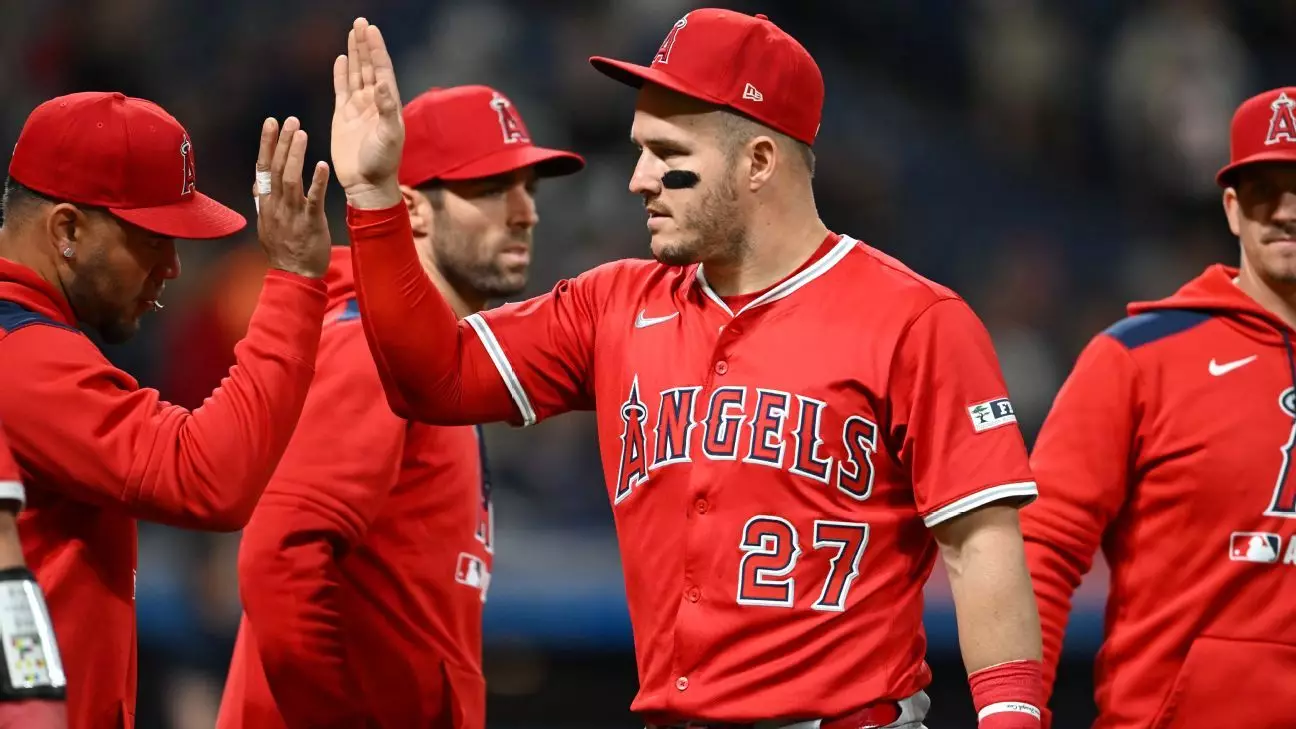Mike Trout, the angelic figure of the Los Angeles Angels and one of baseball’s most venerated players, recently made an anticipated return to the field after an extended absence. Initially expected to rejoin his team during a series in Boston, Trout’s comeback was accelerated, occurring three days sooner than projected. Activated from the injured list, he took the role of designated hitter in a matchup against the Cleveland Guardians, where he managed a single in five at-bats during a 4-1 victory. After missing 26 games due to a bone bruise, following two surgeries last year for a meniscus tear, Trout’s return is a pivotal moment not just for him personally but for the entire Angels organization, which has struggled to maintain its competitive edge in his absence.
Assessing Trout’s Performance
In his first game back, Trout’s numbers may not scream dominance—he batted just .200—but his presence alone sparked a sense of revitalization within the team. The three-time MVP cited that he felt physically poised, aside from striking out in two of his at-bats. This initial outing may serve as a barometer for future performance, with Angels manager Ron Washington praising Trout for making solid contact during the game. It reveals an important aspect: while the statistics will matter, the mentality and sharpness Trout exhibits in his return could ultimately define his season.
Proving that he still possesses the capacity to deliver in crucial moments, Trout’s single through the left-center gap was more than a mere statistic; it signified promise. Moreover, Trout’s unusual batting order position—fifth for the first time in over 1,500 games—underscores how strategic adjustments are being made to accommodate both his return and current form. This unusual batting lineup reflects the Angels’ cautious approach to reintegrating Trout into his normal role, a tactic intended to maximize both his contributions and longevity.
Strategic Decisions and Future Outlook
Washington’s management of Trout is deft; he understands the balance between urgency and caution. The manager’s decision to slot Trout behind rookie catcher Logan O’Hoppe instead of thrusting him back into the second or third slots is a testament to this approach. Trout’s statistics certainly don’t paint a rosy picture—merely .180 with 9 home runs and a .712 OPS in 30 games. But the Angels are acutely aware that repeatedly pushing Trout into the spotlight before he’s ready could risk an injury recurrence, potentially leading to another setback that would devastate both Trout’s career and the team’s aspirations.
The designated hitter position, while not Trout’s first choice, has unexpectedly turned into a comfortable role for him. With a .273 average in limited games at DH this season, there’s an argument to be made that, at least for now, this could be where he thrives. His adaptability may allow the Angels to ease him back into full-time play without overwhelming his recovering knee. The upcoming series in Boston will be an interesting test of whether Trout can once again ascend to the pre-injury form that made him the face of baseball.
Long-Term Considerations
In the broader context, Trout’s career has been marred by injuries that have sidelined him for a significant portion of the past several seasons. Since May 2021, he’s participated in only 261 of the Angels’ 665 games. If Angels management harbors aspirations of making a postseason run, they should be keenly aware of how crucial it is to properly manage Trout’s health, especially as he approaches the latter stages of his career at age 33. The past five seasons have seen Trout relegated to the injured list on multiple occasions, each time raising questions not only about his physical resilience but also about the sustainability of the franchise’s long-term goals.
The organization undoubtedly feels the weight of Trout’s presence; he isn’t just their star but also embodies the heart of a franchise yearning for a renaissance. New rookie O’Hoppe displayed an appreciation for this when discussing Trout’s return, highlighting his presence as a pivotal element within the clubhouse. Such narratives are intertwined with Trout’s legacy, creating a complex tapestry of leadership and loyalty that is vital for building a winning culture.
In a league defined by youth and exuberance, the Angels find themselves at a crossroads: capitalize on Trout’s final years or risk a cycle of mediocrity. Time will tell how this chapter unfolds, but for now, Trout’s return is a powerful reminder of what makes baseball a timeless pursuit. The question remains, will Trout be able to defy the odds once more and guide his team through a season of promise?


Leave a Reply